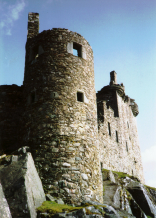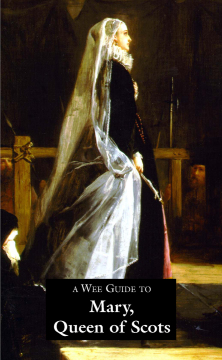Mary Queen of Scots: Mary’s Personal Rule
Although she may have intended to permit freedom of worship for her Protestant subjects, Mary also felt that to an extent, as a rightful monarch, she should have some
authority over the spiritual comfort of her subjects. She also had some insight into the fact that religious unrest could turn to civil unrest, and was anxious to avoid this possibility. The Queen
therefore agreed to meet John Knox.
The extreme wing of the Protestants had been led by the Earl of Arran, whose own motives were in fact inspired by his thwarted ambition to marry Mary. As this plan was repeatedly
rejected, Arran began to show signs of mental imbalance and he was eventually confined from 1562 until he died in 1609. Arran’s motives may have been more than religious, but that cannot be said of
another leader of the group.
Knox had been a follower of George Wishart, the Protestant preacher burnt by Cardinal Beaton, and had been involved in the siege of St Andrews Castle, after which he was sent to
France as punishment. On his release, he went to England and preached successfully there until the reign of Mary Tudor. Mary Tudor’s anti-Protestant campaign forced Knox to flee to Geneva for safety,
but he returned to Scotland in 1559 to join in the overthrow of Mary of Guise and the Catholics. Knox’s preaching was noted for its vehement anti-Catholic sentiment and on occasion, notably in Perth,
led to riot and iconoclasm, when church carvings and other Catholic icons were destroyed. Knox was appointed minister of Edinburgh on 7 July 1559 but, using his noted powers of self preservation,
removed himself when it looked as if Mary of Guise might hold onto the Regency. On Queen Mary’s arrival, having returned to Edinburgh, he preached a sermon against her taking Mass, even although she
had been guaranteed this privilege.
Their first meeting took place after this sermon and Mary, perhaps because she had been brought up to expect to certain degree of respect for her position of authority as a woman
of royal birth, probably did not expect to hear arguments, which were both anti-Catholic and anti-female, directed at her. She may have thought that she was able to hold her own in discussions of a
religious or political nature, but she had never before encountered such a man and was unable to win him round as she had hoped. Knox unsettled Mary greatly by implying that if subjects were ruled by
a Catholic monarch, then it was their duty to God to disobey that monarch. The interview was not a success, but the ground rules were laid by the two protagonists which neither would be willing to
change.
Mary may have been unsettled by Knox’s clear religious intolerance but she had no intention of embarking on a campaign to enforce Scotland to renounce protestantism. Her attitude
towards the Protestant church, as well as her reassurances to Rome, show that Mary was quite canny and sensible. Some have suggested that her motives were those of self-interest and opportunism,
which may be a little harsh. Given the standards and motives of behaviour of most monarchs of the time, Mary’s actions to ensure her self-preservation were no better and no worse. Realizing the power
of the Protestants, Mary re-affirmed her intention that while she could take Mass privately, priests would not be permitted to say Mass elsewhere. She also granted the reformed church money from
major benefices in February 1562. In theory, the revenues from the benefices went to the holders, but Mary ordained that one third was to be divided between the government and the reformed
church.
It was clear that in order to survive, Mary had to play a game of reconciliation and compromise. Mary worked with her Protestant nobles, acknowledging that it was better to have
them on her side than against her. To this end, she even made it clear that she rejected the counsel and advice of those who had Catholic tendencies. Mary governed the country through her privy
council, which was at this time mostly Protestant. She attended meetings and listened to the debates of her nobles, contributing to the discussion when needed. On the other hand, Mary’s household was
largely made up of those who had accompanied her from France: the four Marys, musicians, poets, dancers, chefs and physicians. She was able to participate in the style of courtly life which she had
enjoyed in France, albeit on a smaller scale. She could listen to the music of David Rizzio and the poetry of Pierre de Châtelard. Both of them played future roles in less pleasant circumstances, but
in the meantime provided Mary with much enjoyable diversion.
The royal court did provide some opportunity for the mixing of Mary’s Protestant Scottish nobles and her predominantly Catholic household, but Mary had another group whose support
and welcome she quickly realized would be important to her. This was of course the Scottish people themselves. Having experienced life at the peripatetic French court, she had seen that moving around
a country would give both monarch and subjects opportunities to see each other. Public journeys throughout the country would enable her to display her political strength and govern her kingdom, as
the privy council could travel with her. Also Mary remembered little of her country of birth and these progresses allowed her to see her kingdom more fully, as well as removing her from Edinburgh and
John Knox. Between 1562 and 1565 two-thirds of the time were spent on royal progresses; between August 1562 and September 1563 she covered 1200 miles and 460 miles between July and September 1564.
The first progress, between 10 August 1562 and 21 November 1562, took Mary to Linlithgow Palace where she had been born. From there she travelled to Stirling, Perth, Coupar Angus, Glamis Castle owned by the Lyon family, Edzell Castle property of the Lindsays, and Aberdeen. She then progressed to the
Earl of Moray’s castle at Darnaway in Moray, Inverness, Spynie Palace which was the property of the Bishop of Moray, Aberdeen again and the
Keith castle at Dunnottar. Next she visited Montrose in Angus, Dundee,
another visit to Stirling and finally back to Edinburgh. She also stayed at the Earl of Atholl’s castle at Balvenie in the September and Arbroath Abbey, in the Abbot’s House, in November of
that year. The progress started well, but at Stirling, as she was hearing Mass at
the Chapel Royal, there was a scuffle inside the chapel involving her half-brother, Lord James. At Perth, although there was a cheering crowd to welcome her, some of the pageants performed had
similar anti-Catholic meanings to the Edinburgh ones. This appeared to upset Mary and reportedly caused her to faint. In 1562 Mary also visited Crichton Castle, property of the Hepburns, to attend the wedding of her half-brother
Lord James to Lady Janet Hepburn.
Part of the progress was to the region of the north-east of Scotland where the Gordon family was very powerful. George Gordon, fourth Earl of Huntly, was an extremely powerful man
in his locality, as well as nationally. He was lieutenant in the north, sheriff of Aberdeen, owned and administered large areas of land and was known to have Catholic sympathies. Indeed, he had
suggested that Mary land at Aberdeen to start a Catholic administration in 1561. Mary had rejected this plan and while this may have contributed to Huntly’s annoyance with her, it may also have been
Mary’s decision about the earldoms of Mar and Moray that really displeased Huntly.
Huntly had been administering and benefiting from these lands until 1562, when Mary decided to grant the titles and lands to Lord James. This probably did not increase her
popularity with the Gordons, although Sir John Gordon, Huntly’s third son, had some plans to persuade Mary of his suitability to be her husband. When Mary reached Inverness, the captain of the
town, who was Lord Gordon, Huntly’s oldest son, refused her entry. Mary’s troops rallied to her side and took the garrison; Lord Gordon was then executed as punishment for his insolence.
Huntly and Sir John Gordon assembled the Gordon forces, intending to block Mary’s progress to Aberdeen: she was however allowed to pass. Huntly was summoned to appear before the
privy council to explain his actions, but as he failed to appear he was put to ‘the horn’ which meant he was declared outlawed and forfeited. Huntly marched on Aberdeen but Mary’s forces, led by Lord
James, now the Earl of Moray, and Maitland of Lethington, met up with the Gordons at Corrichie, near Aberdeen, on 28 October 1562. The battle in the end was quick and the Gordon forces completely
routed. Prior to the battle, the elderly Huntly is reported to have been reluctant to engage in combat, and when he was captured he took a sudden seizure, possibly a stroke, and died. Legend says
that he may have died of apoplexy, but whatever the diagnosis, the Gordons lost much as a result of Corrichie. Sir John was executed and Huntly was posthumously convicted of treason and forfeited.
The Gordon castle at Huntly was sacked as part of the punishment.
1563 was to bring its own problems for Mary. Plans were made for another progress, this time a smaller one to Fife. No matter what political issues were proving problematic or that
there were yet more reports of Knox’s repeated accusations of her Catholic idolatry, Mary was reassured by the obvious pleasure that her subjects expressed when they saw her. Despite taking action
against what might have been perceived as a Catholic plot, Mary still had to appease the reformers more. To this end there were several prosecutions for saying Mass, Mary did not give an audience to
the Jesuit de Gouda and she did not send Scottish representatives to the meetings of the Council of Trent, the forum for discussion between Rome and the reformers, organized by the Catholic church.
There was also the growing speculation, associated with any unmarried monarch, about possible suitors – occupied not only the Scottish people and the nobles, but also Mary herself. The possibility of
a match with Don Carlos of Spain was again discussed, as without the interference of Catherine de Medici, Mary’s own Scottish ambassadors could undertake negotiations.
These issues remained among Mary’s concerns as she set off on 11 February 1563 to Rossend Castle, near Burntisland. Members of her household travelled with her, amongst them Pierre
de Châtelard, a young French poet whose admiration of the Queen had turned to infatuation and passion. In an incident at Holyrood, following a masque where the closest members of Mary’s court dressed
up in clothes of the opposite sex, Châtelard was found concealed under Mary’s bed by her attendants. Mary was very upset and angry, and ordered the poet to leave her court. As there were no attempts
to ensure that he had obeyed the queen’s orders, Châtelard was still with the queen’s household when it arrived at Burntisland.
In the evening, when Mary retired to her bedchamber, he followed her and forced his way in, to find her being disrobed by two of her Marys. There he made physical advances to her
until the Earl of Moray, Lord James, came to her aid. These two episodes were fuel for the fires of rumour- and scandal-mongers, and Châtelard had to be dealt with severely in order to maintain the
queen’s dignity. After being imprisoned he was tried and executed at St Andrews, where before he died he quoted from Ronsard’s poem ‘Hymn to Death’. Despite the attempts at damage limitation, Knox
still managed to use these incidents in his continued criticism of Mary.
The progress through Fife continued from St Andrews to the royal palace at Falkland and then back to Edinburgh by 18 May, and as she went round the country debate continued about
Mary’s possible marriage. There was no doubt that she wanted to re-marry, but she was aware that whoever was chosen had to be acceptable to more than just herself and her council. Her French
relatives continued to advise her by letter, still hoping for a powerful Catholic union; and there was also the small matter of Mary’s claim as heir to the English crown.
Elizabeth had neither married, nor named her chosen heir. Mary was well aware that any marriage might influence Elizabeth’s decision, and therefore she sent Maitland of Lethington
to negotiate with Elizabeth on her behalf. The stumbling block, as far as Elizabeth was concerned, was that Mary had thus far refused to ratify the Treaty of Edinburgh, in which Mary would agreed to
refrain from calling herself Queen of England. Mary, for her part, used the excuse that she could not ratify any treaty without the consent of her parliament, which of course had not met since she
had returned. International discussions about the possible Spanish marriage were to continue, much to the annoyance of Elizabeth, who played her trump card of the English succession – if Mary would
marry someone of her choice then Elizabeth might agree to name Mary as her heir. As early as spring 1563 Elizabeth suggested as a possible match Robert Dudley, later created Earl of Leicester, who –
it was rumoured – was Elizabeth’s lover.
On 1 July 1563 Mary set out on another progress, this time to the west, Dumfries and Galloway and the borders. From Edinburgh she travelled to Dunipace, Glasgow, Hamilton centre of
the Hamilton family lands, then to Dumbarton Castle and to Inveraray Castle, centre of the Campbell Earl of Argyll, another of her Protestant nobles. She then moved to Dunoon, and Eglington,
stronghold of the Montgomery Earls of Eglington. Hugh Montgomery, the third earl, was a devout Catholic who remained loyal to Mary throughout her reign. Next, she progressed south along the coast to
Ayr and then to Dunure, owned by the Kennedys, Earls of Cassillis, another loyal Catholic family. Travelling further south Mary moved to Ardmillan and Ardstinchar held by the Kennedys of Bargany. The
entourage then headed to the Abbey of Glenluce and the Priory of Whithorn, both well known religious sites and pilgrimage routes. Next stop was Kenmure
Castle, owned by the Gordons, Viscounts of Kenmure, St Mary’s Isle and then Dumfries. Moving north Mary then called at Drumlanrig Castle property of the Douglas family and Crawfordjohn owned by the
Hamiltons, Couthalley owned by the Somervilles, then the Cockburn stronghold of Skirling Castle. The next port of call was at Neidpath Castle, near Peebles, owned by the Hays. Then Borthwick, south
of Edinburgh, followed by Dalhousie held by the Ramsays and Roslin, the property of the Sinclairs of Roslin. The progress ended back in Edinburgh in September 1563 after a visit to Craigmillar Castle
just outside the city. It is clear from her itinerary that Mary was careful to show no obvious preference between Protestant and Catholic families and attempted to balance her
favours.
By the middle of 1564 the possible marriage between Don Carlos and Mary was finally called off, due to the Spanish prince’s insanity, and in July Mary once again set off on her travels. In England Elizabeth and her advisors continued to discuss other possible husbands for Mary. This progress between 21 July and 15 September took Mary to Linlithgow again followed by Perth, Blair Castle the Earl of Atholl’s stronghold, Inverness, Gartly Castle property of the Barclays, Aberdeen and Dundee. Elizabeth continued to plead for Lord Dudley as a possible husband for Mary, but although Maitland was in discussions about the match, it was the appearance at court of another young man who was ultimately to play an important role in the fate of Mary and Scotland.
© Joyce Miller & Martin Coventry 2018









